Eyes on the exit: Selling PE portfolio companies in complex markets
JD Supra: Mergers
MARCH 19, 2025
By: White & Case LLP
This site uses cookies to improve your experience. To help us insure we adhere to various privacy regulations, please select your country/region of residence. If you do not select a country, we will assume you are from the United States. Select your Cookie Settings or view our Privacy Policy and Terms of Use.
Cookies and similar technologies are used on this website for proper function of the website, for tracking performance analytics and for marketing purposes. We and some of our third-party providers may use cookie data for various purposes. Please review the cookie settings below and choose your preference.
Used for the proper function of the website
Used for monitoring website traffic and interactions
Cookies and similar technologies are used on this website for proper function of the website, for tracking performance analytics and for marketing purposes. We and some of our third-party providers may use cookie data for various purposes. Please review the cookie settings below and choose your preference.

JD Supra: Mergers
MARCH 19, 2025
By: White & Case LLP

OfficeHours
JUNE 6, 2023
Private equity is an investment asset class that has gained significant prominence and popularity in recent decades. It has become a preferred choice for investors seeking attractive returns and diversification from traditional investment options such as stocks and bonds.
This site is protected by reCAPTCHA and the Google Privacy Policy and Terms of Service apply.

OfficeHours
AUGUST 9, 2023
To know if the buyside is right for you, let’s start with a textbook understanding of “What is private equity?” Private equity involves investing capital directly into private businesses that are not publicly traded on stock exchanges (that would be a hedge fund). Strategic thinking skills are essential.

OfficeHours
OCTOBER 20, 2023
For private equity investors who have been monitoring the situation around inflation for the last few months to a year, many have been disappointed to see the slow trajectory with which inflation has been coming down from highs. Explore the role of private equity now. Currently, inflation in the U.S.

OfficeHours
OCTOBER 16, 2023
For private equity investors, one of the most important considerations for a successful investment is determining the value the firm will receive at exit, which directly impacts fund returns. Private equity investors often have a 5 to 7-year investment horizon and expect a significant return at the end of this hold period.

OfficeHours
OCTOBER 23, 2023
However, for private equity investors, this uncertainty represents a unique opportunity to take advantage of investment opportunities in public markets. A “take-private” transaction in the context of private equity is a process by which a PE firm acquires a publicly listed company and converts it into a privately held entity.

OfficeHours
OCTOBER 16, 2023
For private equity investors who have been monitoring the situation around inflation for the last few months to a year, many have been disappointed to see the slow trajectory with which inflation has been coming down from highs. Currently, inflation in the U.S.

Mergers and Inquisitions
MARCH 13, 2024
Some argue that GE offers the best of both worlds: the opportunity to fund innovation and growth – as in venture capital – plus the ability to limit downside risk and invest in proven companies – as in private equity. The Top Growth Equity Firms Why Did Growth Equity Get So Popular?

OfficeHours
OCTOBER 16, 2023
However, for private equity investors, this uncertainty represents a unique opportunity to take advantage of investment opportunities in public markets. A “take-private” transaction in the context of private equity is a process by which a PE firm acquires a publicly listed company and converts it into a privately held entity.
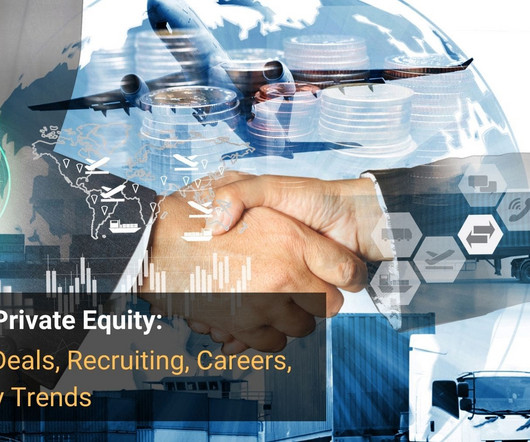
Mergers and Inquisitions
JULY 31, 2024
If you ever tire of the hype around tech, industrials private equity might be an ideal hiding spot. Morgan’s acquisition of Carnegie Steel in 1901 – was an industrials private equity deal. Table Of Contents Industrials Private Equity Defined What Has Drawn Private Equity Firms to Industrials Companies?

Mergers and Inquisitions
DECEMBER 4, 2024
But this started changing in the 2010s and early 2020s as team values skyrocketed and billionaires, sovereign wealth funds , and sports private equity firms all jumped into the sector. SPAC IPOs for esports companies were “hot” for a short period in 2021, but they seem to have died off by now.
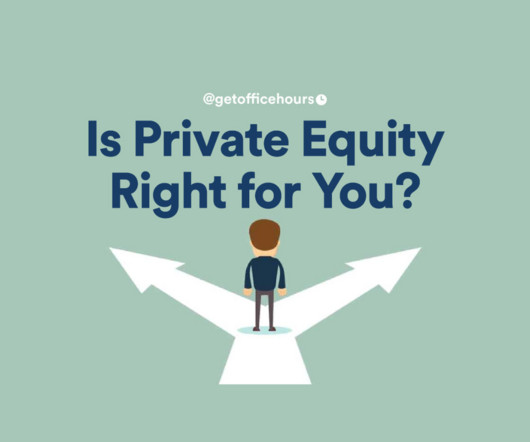
OfficeHours
AUGUST 20, 2023
Written by a Top OfficeHours Private Equity Coach Is PE a Good Fit for you? To know if the buyside is right for you, let’s start with a textbook understanding of “What is private equity?” Many first-year (and some second-year) analysts are unsure if private equity should be their next step.

Mergers and Inquisitions
NOVEMBER 1, 2023
When you hear the words “healthcare private equity,” two thoughts probably come to mind: Wait a minute, isn’t healthcare a risky/growth-oriented sector? In most of the world, healthcare is either government-run or a mixed public/private sector. Are there many private healthcare companies for PE firms to acquire?

Cooley M&A
DECEMBER 14, 2020
The bankers on the panel shared the belief that the quality of SPAC sponsors has increased as private equity firms, successful dealmakers and well-regarded VC investors launching their own SPACs. Going Public via a SPAC vs. an IPO or Direct Listing.

Devensoft
AUGUST 21, 2023
In the fast-paced world of mergers and acquisitions (M&A), two titans of finance go head-to-head: venture capitalists and private equity firms. On the other side of the ring, private equity firms are focused on acquiring established businesses, restructuring them, and driving operational efficiencies to maximize returns.
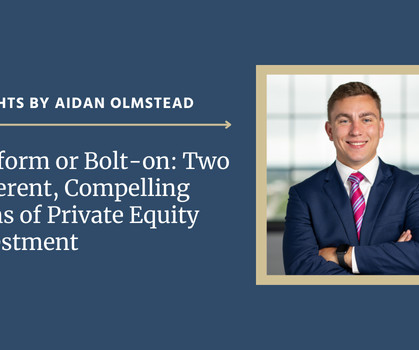
Chesapeake Corporate Advisors
AUGUST 16, 2024
Private equity (PE) firms are investing in middle market businesses at a healthy pace despite a high interest rate environment that makes it more costly to finance deals. These investors are attracted to well-run businesses with positive cash flows, a diverse customer base, and strong industry tailwinds.

Wizenius
AUGUST 16, 2023
Private Equity (PE) often becomes the coveted next step for many investment bankers, promising new dimensions within the financial landscape. 6) Investor Relations: Sustaining a steady stream of capital for future investments is crucial for PE firms.

Wizenius
SEPTEMBER 28, 2024
Leverage Buyouts (LBO) are a strategic financial maneuver where a financial sponsor, typically a private equity firm, acquires a target company by utilizing a substantial amount of debt alongside a smaller portion of equity. In an LBO scenario, both debt and equity investors commit capital to the target company.

Focus Investment Banking
FEBRUARY 25, 2024
First, there’s the ability to raise substantial capital by issuing shares to the public in an initial public offering (IPO), as well as secondary offerings. Lastly, going public is a liquidity event for the founders and early investors, allowing them to cash in on their success. It’s just that companies are staying in private hands.

Growth Business
JUNE 1, 2023
By Brooks Newmark on Growth Business - Your gateway to entrepreneurial success The success of Dragons’ Den has long thrust angel investors into the spotlight, but away from the heat and drama of the den, angel investment is a crucial component of the UK start-up ecosystem. Don’t invest in someone who is a nice guy and seems smart.

Growth Business
JULY 26, 2023
There might be marginal differences, such as Series B1’s round not ending in an investor taking a board seat and B2’s does, for example. In terms of equity, the rule of thumb is 20 per cent per round but in recent years, it’s edged closer to 10 to 15 per cent per round. How to pitch to investors: What fundraising collateral do I need?

Mergers and Inquisitions
MAY 24, 2023
Here’s how these strategies compare on the “trading vs. private equity” spectrum: The big selling point of the “middle” strategies – special situations and distressed – is that their returns are relatively uncorrelated with the overall market , and they have greater potential upside than something like merger arbitrage.

Growth Business
JULY 17, 2024
Angel investors A business angel is someone who quite often has a background in business or finance, and has funds to invest in businesses. Equity finance Equity finance involves raising capital for a business by selling shares of ownership to investors in exchange for funding.

Mergers and Inquisitions
OCTOBER 18, 2023
Investment Banking: Deals The basic difference is that in “investment banking” groups, such as technology , TMT , healthcare , or consumer retail , you work on various deal types: sell-side and buy-side M&A, leveraged buyouts, IPOs, follow-on offerings, and bond issuances. or debt offerings (investment-grade or high-yield bonds).

The Deal
OCTOBER 17, 2023
Direct-to-consumer businesses, darlings of the investor community in 2021, saw their techlike valuations plummet. But some subsectors, such as beauty, fragrance, residential services and medical spas, remained active as risk-off investors shifted deal activity toward categories they view as less discretionary, according to Leonhardt.

Focus Investment Banking
APRIL 14, 2024
These characteristics, coupled with bakery manufacturers’ ability to continually innovate and adapt to consumer trends, have attracted investors and boosted M&A activity in recent years. General Mills acquired private equity-backed TNT Crust, a frozen pizza supplier, for $253 million. The $75 billion U.S.

Francine Way
JULY 8, 2017
Many of these causes have their equivalences to the reasons behind the sale of a company (also known as a divestiture): Liquidity: As the equity holding period matured, investors (private equity funds behind companies) will look to sell.
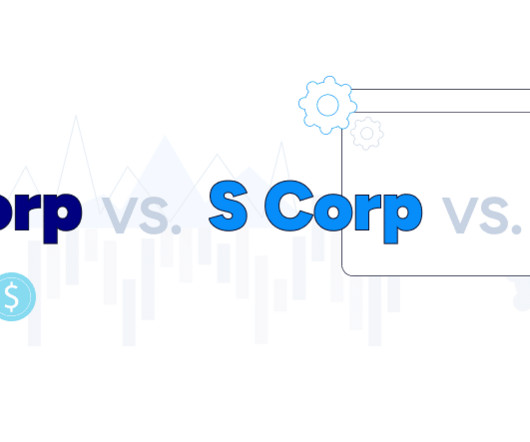
Software Equity Group
SEPTEMBER 17, 2024
The decision between forming a C Corp, S Corp, or LLC can significantly affect your company’s tax obligations, flexibility in ownership, and attractiveness to investors. The flexibility to have multiple stock classes is a major draw for institutional investors. Are S Corps Ideal for Software Companies?

Cooley M&A
SEPTEMBER 16, 2022
There are compelling rationales for adopting a dual-class structure, but even proponents of the structure generally acknowledge that these benefits are significantly mitigated once the dual-class shares are out of the hands of the founders and/or pre-IPO stockholders. Potential carve outs for M&A voting agreements. Stockholder litigation.

Sun Acquisitions
SEPTEMBER 16, 2024
Take a strategic approach by assessing your business’s strengths, weaknesses, opportunities, and threats (SWOT analysis), identifying potential buyers or investors, and determining your desired exit timeline. Start early, ideally years before you intend to exit, to allow sufficient time for preparation and implementation.

Cooley M&A
JANUARY 20, 2022
While R&W insurance has been a staple for private equity buyers for several years, the increased adoption of R&W insurance by strategic acquirers in acquisitions of private targets is a notable trend – almost 30% of all R&W policies in 2021 were procured by strategic buyers. [1]. On January 3, in the MultiPlan Corp.

Peak Frameworks
SEPTEMBER 19, 2023
This critical phase lays the groundwork for the business's future journey , making it essential for potential investors and stakeholders to understand. Funding may come from a variety of sources including personal savings, family and friends, angel investors, or venture capitalists.
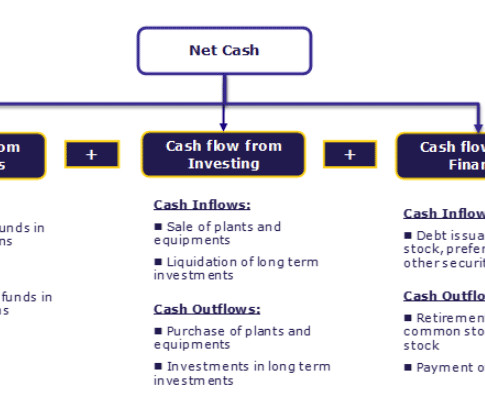
Wall Street Mojo
JANUARY 17, 2024
It aids investors in analyzing the company's performance. read more like investors, shareholders Shareholders A shareholder is an individual or an institution that owns one or more shares of stock in a public or a private corporation and, therefore, are the legal owners of the company. read more arising from each activity.

Mergers and Inquisitions
SEPTEMBER 11, 2024
For growth-stage companies, you will see plenty of equity offerings: IPOs , SPACs , PIPEs, and follow-on issuances. Since equity deals are highly dependent on market conditions, deal flow tends to be much more uneven than in asset-level M&A.

Mergers and Inquisitions
SEPTEMBER 20, 2023
Q: Why not private equity, growth equity, hedge funds, or entrepreneurship? Venture Capital Interview Questions: Markets and Investments These questions span a wide range, as they could ask you to discuss everything from the current M&A and IPO markets to specific startup sectors you like.

Peak Frameworks
OCTOBER 30, 2023
Volatile markets often lead to more trading activity as investors look to buy low and sell high. When Facebook went public in 2012, it needed an investment bank to handle the Initial Public Offering (IPO). 2019 was a notable year for trading, especially for banks like J.P.

Razorpay
AUGUST 9, 2023
Portfolio Management Merchant banking companies provide portfolio management services to high -net-worth individuals and corporate investors. Underwriting Services Merchant banks also provide underwriting services for initial public offerings (IPOs), private placements, follow-on public offerings (FPOs) and rights issues.

Mergers and Inquisitions
JANUARY 24, 2024
It’s an excerpt from our Venture Capital & Growth Equity Modeling course , so it’s not a step-by-step walkthrough – but it should still be quite helpful: Types of Growth Equity Case Studies Growth equity firms are “in-between” venture capital and private equity firms.

Software Equity Group
OCTOBER 22, 2024
Understanding and optimizing NRR has become crucial for software companies looking to drive sustainable growth and attract buyer and investor interest. A high NRR is evidence of strong customer relationships, predictable revenue, and the potential for compounding growth, all which appeal to buyers and investors.

Cooley M&A
JANUARY 23, 2024
Complex and novel transaction structures for the sector also were a prominent result of the market and regulatory environment, with reverse mergers remaining a fixture and stock-for-stock deals and take-private transactions led by private equity sponsors entering the scene. billion.

Cooley M&A
NOVEMBER 1, 2018
government shutdown disrupting the market for IPOs, Brexit uncertainty, natural disasters and various other crises, cross-border M&A activity momentum continues. In what remains largely a low organic growth environment, deals were being funded by the record levels of dry powder held by private equity and cash piles repatriated by U.S.

Mergers and Inquisitions
JANUARY 10, 2024
There is some overlap because at the large banks, wealth management clients often get early/privileged access to investment banking products, such as upcoming IPOs, equity/debt offerings, or new investment products. Investment Banking: Deep and short-term coverage (just until the deal is done!).

Mergers and Inquisitions
APRIL 10, 2024
Amidst the miserable deal environment of the past few years, there has been one bright spot: sports private equity. Over two-thirds of NBA teams have a private equity connection or investment , and all major U.S. Table Of Contents Sports Private Equity Defined Why Did Private Equity Suddenly “Get Interested” in Sports?

The Deal
NOVEMBER 9, 2023
And sales of companies to investor Ron Perelman and private equity firms KKR & Co. And while Sloan said he believes deeply in SPACs serving a purpose in bringing companies public, he revealed that for most companies, a traditional IPO is a better fit. trying to bring the Hollywood studio back from the dead.
Expert insights. Personalized for you.
We have resent the email to
Are you sure you want to cancel your subscriptions?


Let's personalize your content